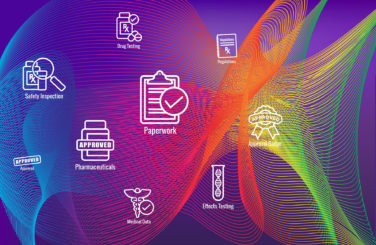Clinical trial recruitment is a lengthy and complex process involving stringent protocols and the coordination of many people across multiple healthcare verticals. Delays in starting trials result in delays in getting a treatment to market and into the hands of the people who need it most to improve their health. The application of artificial intelligence (AI) to the recruitment process can make it more efficient by reducing reliance on direct-to-consumer (DTC) outreach by instead identifying physicians who have potentially eligible trial participants, according to the parameters of the protocol.
Once a clinical trial’s inclusion and exclusion criteria are determined, the next step is to activate trial sites and recruit patients that fit the trial’s subject profile. This patient identification and recruitment phase typically involves analyzing real-world data (RWD) sets to locate eligible patients, and then strategizing ways to reach them—often relying on a traditional DTC effort in combination with a smaller referring physician strategy. The outreach and recruitment phase can be time-consuming and costly since manufacturers are most often attempting to reach patients directly, through a variety of channels including in-hospital recruitment, ads in various print and digital publications, social media ads, and more.
At a high level, these outreach options may be separated into non-personal promotion to patients, outreach to potential referring physicians, and awareness outreach to institutions. The non-personal promotion approach has issues with the specificity of targeting, while personal promotion directly to patients is largely not possible due to HIPPA regulations. Even when patient outreach succeeds, the next challenge is that not every patient who shows interest will be eligible, and not every eligible patient will be invested enough to follow through with the trial.
The stakes here are high. According to an inVentiv Health e-recruitment study, each day a drug program is delayed costs the sponsor an additional $37,000. On the other hand, outreach to physicians and institutions is highly complex and often loses much of the efficiency garnered from the analytics identifying potentially eligible patients. This outreach may also face other significant challenges as not all facilities are set up for efficient patient referral, or able to conduct a trial for a given therapy.
All these methods to bring patients into the top of the clinical trials funnel are cumbersome, slow, inefficient, and expensive. Because of all this, upwards of 85% of clinical trials don’t meet their target patient population within their recruitment period, according to Definitive Healthcare, a healthcare commercial intelligence provider.
Leveraging AI for Greater Efficiency
AI has been leveraged in healthcare for a while now, but what has changed since AI was introduced is that the technology available to healthcare stakeholders is better, and the data sets to pull intelligence from are bigger. Access to bigger data sets means more relevant and up-to-date information to analyze and act on in a timely manner, enabling trial recruitment teams to create smarter engagement programs—particularly directed to referring physicians.
Clinical trials are an important resource to a physician’s treatment planning for underserved and chronic condition populations but are often missed by potential referrers due to lack of visibility at the right time. While the traditional outreach to patients has proven to be cumbersome and time-consuming, with no guaranteed eligible patients, drug manufacturers can apply AI to RWD to identify physicians who are actively treating the profile of patients who would qualify for their clinical trial.
Physicians with pre-qualified patients can then be prioritized to receive study messaging at the exact time their patients become potentially eligible, increasing the likelihood of a pre-qualified referral, and effectively reducing time to study enrollment. This application of AI at the point of care allows clinical trial recruitment teams to change the formula in a way that is more efficient for manufacturers, physicians, and most importantly for patients.
This also enables life sciences companies to better identify potentially eligible patients more precisely for trials, creating smarter engagement programs that “fast-track” the recruitment of patients who meet the trial criteria in a shorter amount of time. Cutting down outreach and recruitment time has the potential to accelerate reaching a sufficient volume of patients for the trial to proceed and eventually bring potentially life-extending treatments to market sooner.










